Fake Binance NFT Mystery Box bots steal victim’s crypto wallets
A new RedLine malware distribution campaign promotes fake Binance NFT mystery box bots on YouTube to lure people into infecting themselves with the information-stealing malware from GitHub repositories.
Binance mystery boxes are sets of random non-fungible token (NFT) items that people buy, hoping they’ll receive a unique or rare item at a bargain price. Some of the NFTs found in these boxes can be used to add rare cosmetics or personas within online blockchain games.
Mystery boxes are trendy in the NFT market because they give people the joy of the unknown and the potential for a big payday if they land a rare NFT. However, marketplaces like Binance offer them in limited numbers, making some boxes hard to get before they run out of stock.
This is why interested buyers often deploy “bots” to acquire them, and it’s precisely this hot trend that the threat actors are trying to take advantage of.
YouTube and GitHub abuse
According to a new report by Netskope, threat actors are creating YouTube videos to entice potential victims into downloading and installing the malware on their computer, thinking they’re getting a free mystery box scalper bot.
.png)
BleepingComputer confirmed that the videos listed in the indicators of compromise are still available on YouTube, albeit having a low number of views.
There likely are many more than those spotted by Netskope, and it’s also possible that previous scam videos with a higher number of views were reported and taken down by YouTube moderators.
The threat actors uploaded the videos between March and April 2022, and they all feature a link to a GitHub repository that supposedly hosts the bot but, in reality, distributes RedLine.

The name of the dropped file is “BinanceNFT.bot_v1.3.zip”, containing a similarly-named executable, which is the payload, a Visual C++ installer, and a README.txt file.

(Netskope)
RedLine requires the VC redistributable installer to run since the program is developed in .NET, while the text file contains the installation instructions for the victim.

In this campaign, RedLine was configured to exit if the malware detected the country on the host computer to be Russia, Ukraine, Belarus, Armenia, Azerbaijan, Kazakhstan, Moldova, Uzbekistan, Tajikistan, or Kyrgystan.
In addition to the RedLine campaign seen by Netskope, BleepingComputer noticed newer YouTube campaigns promoting a free ‘Binance NFT Bot.’

Source: BleepingComputer
However, these campaigns are using rebrand.ly URLs that redirect to downloads hosted on MediaFire. According to VirusTotal, this campaign is also distributing password-stealing trojans.
RedLine threat continues
RedLine is a very popular and potent threat in the information-stealing malware space, being distributed by multiple threat actors and in a wide variety of ways.
It’s currently sold to independent operators under a subscription model for $100 per month and supports the stealing of login passwords and cookies from web browsers, data from chat apps, VPN credentials, and cryptocurrency wallets.
In cryptocurrency-themed campaigns, such as this one, the victims typically possess digital assets and cryptocurrency, making the financial damage even more significant.
One thing to always keep in mind is that the legitimacy of platforms like YouTube and GitHub does not automatically equate to content trustworthiness, as the upload checks and the moderation procedures on these sites are lacking.
Clicking on links provided under or on videos uploaded by small and obscure YouTube channels, downloading executable files, and running them on your system is never a good idea.
Credit: Source link


 Bitcoin
Bitcoin  Ethereum
Ethereum  Tether
Tether  Solana
Solana  USDC
USDC  XRP
XRP  Lido Staked Ether
Lido Staked Ether  Dogecoin
Dogecoin  Toncoin
Toncoin  Cardano
Cardano  Shiba Inu
Shiba Inu  Avalanche
Avalanche  Wrapped Bitcoin
Wrapped Bitcoin  Bitcoin Cash
Bitcoin Cash  TRON
TRON  Polkadot
Polkadot  Chainlink
Chainlink  Internet Computer
Internet Computer  Polygon
Polygon  Litecoin
Litecoin  NEAR Protocol
NEAR Protocol  Uniswap
Uniswap  LEO Token
LEO Token  Dai
Dai  Aptos
Aptos  Ethereum Classic
Ethereum Classic  Mantle
Mantle  First Digital USD
First Digital USD  Stacks
Stacks  Filecoin
Filecoin  OKB
OKB  Cronos
Cronos  Stellar
Stellar  Cosmos Hub
Cosmos Hub  Render
Render  Renzo Restaked ETH
Renzo Restaked ETH  Arbitrum
Arbitrum  Immutable
Immutable  Bittensor
Bittensor  Hedera
Hedera  Maker
Maker  dogwifhat
dogwifhat  The Graph
The Graph  Injective
Injective  Optimism
Optimism  Ethena USDe
Ethena USDe  Fetch.ai
Fetch.ai
Comments are closed.